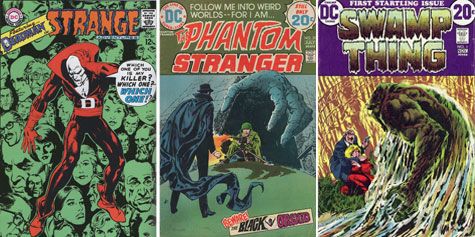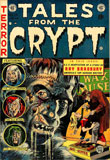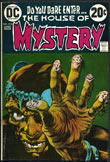
The first stirrings might have begun with the Deadman, an acrobatically-inclined ghost who inhabited the bodies of mortals for a few moments at a time; or it might have really become a trend when the Swamp Thing arose from eons-old muck to stalk horrors in a world blotted with shadows; and maybe I never noticed it until the Phantom Stranger, addressing readers directly, invited them to follow him into weird worlds.
The omens abounded in the four-color pages coming out of DC Comics in the late 60s and early 70s; voices sounded from the other side, the dead returned to fight crime, and the keepers of ancient secrets imparted dire warnings to the unwary. I came across the secret signs in the longboxes of the comic shops, where I sought to complete my collections of yellowing back issues. And years later, I'd see the pattern behind it all.
DC's horror and supernatural comics of that time had a distinct look and flow; the names behind them appeared again and again on the title pages. They were part of a trend, one that keeps influencing comics and their related media today, with the Constantine film and TV show being the most obvious examples.
 Roots of the trend began in the crime and horror comics published by EC in the 50s—Vault of Horror, Tales from the Crypt, Haunt of Fear, Crime SuspenStories, and others pulled no punches, and their fevered depictions of sadism and brutality prompted their own censure and the creation of a Comics Code Authority to ensure that things didn't get that blood-soaked again.
Roots of the trend began in the crime and horror comics published by EC in the 50s—Vault of Horror, Tales from the Crypt, Haunt of Fear, Crime SuspenStories, and others pulled no punches, and their fevered depictions of sadism and brutality prompted their own censure and the creation of a Comics Code Authority to ensure that things didn't get that blood-soaked again.
The comics industry responded by publishing more titles that appealed to girls, and for a while, True Romance and teen soap operas found an appreciative audience. But by the late 60s, the formula wasn't working anymore, and the comics industry had to find something else that could capture the attention of young readers.
Marvel Comics struck gold—and eventually the mother of all diamond mines—with a pantheon of psychologically fragile superheroes that appealed to schoolboys and their college counterparts. Still looking to reach girls, DC took note of TV’s gothic drama Dark Shadows. Castles full of secrets and elegant vampires now had a healthy female audience, and DC got the hint.
Carmine Infantino, DC's editorial director, hired his old high school buddy Joe Orlando in 1968, putting everything in place for a journey into the eerie and the uncanny. Orlando had worked at EC back in the day, and felt the time was right to revive those old tales of horror and thwarted criminals—albeit, in a lighter version.
The Comics Code people were becoming more permissive, so DC retooled some old series and launched some new ones, and comic fans lapped them up. The new comics had crumbling old mansions, wailing spirits, long-buried secrets, and sinister hosts galore, giving Dark Shadows a serious run for its money.
 In 1968, Orlando introduced Cain, the able caretaker of The House of Mystery. The series, which had been running superhero stories, became a supernatural anthology in the EC mold. The Witching Hour debuted shortly thereafter, and in 1969, the series House of Secrets would also sport a supernatural anthology format and gain its own caretaker, Cain's long-suffering brother Abel.
In 1968, Orlando introduced Cain, the able caretaker of The House of Mystery. The series, which had been running superhero stories, became a supernatural anthology in the EC mold. The Witching Hour debuted shortly thereafter, and in 1969, the series House of Secrets would also sport a supernatural anthology format and gain its own caretaker, Cain's long-suffering brother Abel.
Ghosts and Weird War Tales (featuring tales of the undead and the supernatural on the battlefield) came out in 1971, followed by Weird Western Tales in 1972.
Several of the best artists working in the field made impressive contributions to these titles, but perhaps one of the most significant artists was Tony DeZuniga, who did such a standout job in Weird Western Tales, with a character named Jonah Hex, that the scarred gunslinger got his own series (and eventually an awful movie).
DeZuniga convinced Infantino and Orlando to hire his fellow Filipino artists to produce drawings for DC, and Orlando found outlets for their cinematic style at DC's anthology titles, with some of them moving on to draw superheroes. But the new breed of crime fighters coming out of this ghostly, gothic laboratory in the early 70s was distinctly different from the Super Friends.
Deadman had appeared in Strange Adventures and continued to appear in Adventure Comics. The Phantom Stranger, a character originally from the 50s, got a new series starting in 1969, and Len Wein and Bernie Wrightson created The Swamp Thing in 1971 and started his series the next year. The Spectre, an all-powerful and all-vengeful super-spirit created back in 1940 by none other than Superman creator Jerry Siegel, got a new round of terrifying exploits in the pages of Adventure Comics. Several more followed, until the trend started dying down, probably with Madame Xanadu and her comic Doorway to Nightmare in 1978.
But appropriately, the trend never entirely died, and DC remained the company with the strongest collection of supernatural heroes and protagonists—creations that would come roaring back to prominence in the 80s, especially when DC launched its Vertigo line. Night Force, The Sandman, Hellblazer, and Justice League Dark, to name a few, have kept the lineage going strong into an age where superheroes dominate film and television.
We shall now step into those weird worlds the Phantom Stranger mentioned, and take a closer look at DC’s creepy heroes.
Stay tuned as we feature a new DC superweirdo each week in the new series: Follow Me Into Weird Worlds!
Hector DeJean can frequently be found in comic stores, bookshops, and the Eighties. His serialized story of a private detective who only solves food-related crimes is no longer online.

